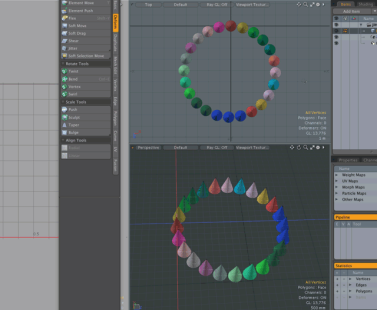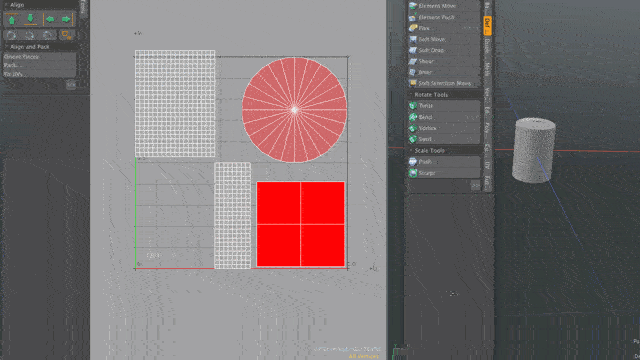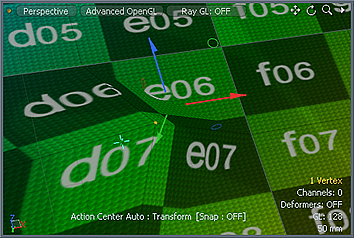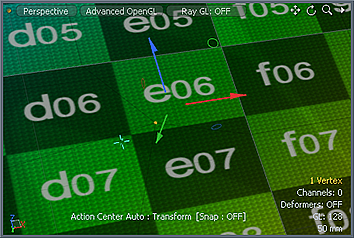Jitter Tool
The Jitter tool repositions selected items or components based on a seed number and a range value for the X, Y, and Z axes. It applies a random offset to each vertex or item position for a more random, organic appearance.

Using Jitter
You can find the tool in the Model layout, in the Deform sub-tab of the modeling toolbox (sometimes as a sub-option of the Smooth or Quantize tools).
| 1. | Click the Jitter button. If it is not visible, click and hold the Smooth/Quantize button to reveal the additional options, then select Jitter. |

| 2. | With the tool active, drag in the viewport to interactively apply the jitter, or type Range values in the tool's Properties panel, and then click Apply. |
Changing the Seed value changes the random numbers to produce a variation on the results. This tool uses any active falloffs to target specific areas for the jitter.
Example Workflow
The following is an example of using the Jitter Tool to create a fence with random spacing between each post. This is done by duplicating using the Clone tool. By default the Jitter is applied to the vertices. By enabling the Rigid Translate, Rigid Rotate, and Rigid Scale options, all the duplicates are treated as individual objects. Use these options to quickly create real geometry without having to use Replicators.
Once created, we can use this model to apply a texture image map with random jitter effects, which can be used in a Games Engine. To view a random texture on all duplicates, you can quickly view the results in the 3D viewport without having to render your scene.
To create a fence post:
| 1. | Open the Model layout, under the Basic sub-tab in the Toolbox, and click Cube |
| 2. | In the properties on the left panel, set Segment X to 2 and then click-and-drag a shape in the 3D viewport. |
The following properties were used in this example.
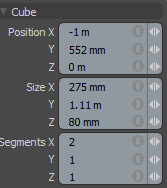
Tip: Use the scale transform square handles to make the initial shape.
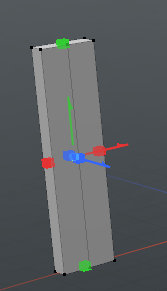
| 3. | Under the menu bar and above the 3D viewport, click Edges. |
| 4. | Click on the top center edge of the fence post to activate it and press W to activate the Move tool. |
| 5. | Drag the transform handle upwards to make a peaked fence post. |
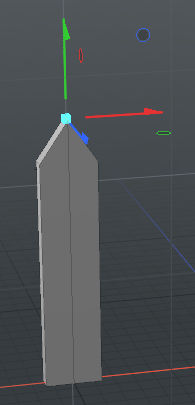
| 6. | Press the Spacebar to drop the tool. |
Create a new UV map:
| 1. | On the right panel, with the Items tab open, navigate to the bottom of the panel and open the Lists tab. |
| 2. | Expand UV Maps, right-click on Texture, and click Clear. |
| 3. | In the UV sub-tab on the Toolbox, click Project. |
| 4. | In the Create UV properties on the Toolbar, set the Projection Type to Atlas. |
| 5. | From the main menu, click Texture > Open UV Editor and verify that you see a similar layout below in your UV Editor. Alternatively, open the UVEdit layout. |
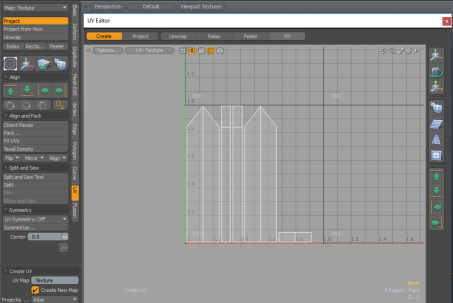
To duplicate the fence post:
| 1. | Under the menu bar and above the 3D viewport, click Polygons, and double-click on the fence post mesh. |
| 2. | On the Toolbox, open the Duplicate sub-tab, and click Clone. |
| 3. | Set the Number of Clones to 10 and click-and-drag in the 3D viewport to position the duplicates. |
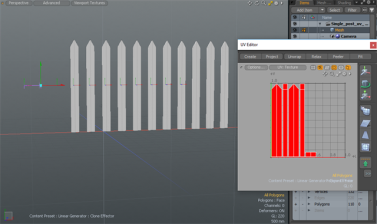
| 4. | Press the Spacebar twice to drop the tool. |
To add randomness to the fence:
| 1. | In the Items tab, on the right panel, select the Mesh item. |
| 2. | Under the menu bar and above the 3D viewport, click Edges. |
| 3. | Lasso Select all of the fence posts. |
| 4. | On the Toolbar, open the Deform sub-tab and click Jitter. |
| 5. | Set the Range for the X , Y, and Z values to 29 mm, 10 mm, 10 mm respectfully. |
| 6. | Enable Rigid Translate, Rigid Rotate, Rigid Scale, and click Apply. |

The fence posts are now randomly place.
| 7. | In the List tab, expand UV Map, right-clickTexture, and select Clear. |
| 8. | On the left panel, open the UV tab, and click Project. |
A new set of UVs is created for all fence posts.
To create random texture:
| 1. | On the right panel, open the Shading tab, and select Base Material. |
| 2. | Click Add Layer > Image Map > (load Image), select a texture image, and click Open. |
The fence posts all have the a random texture image map applied.
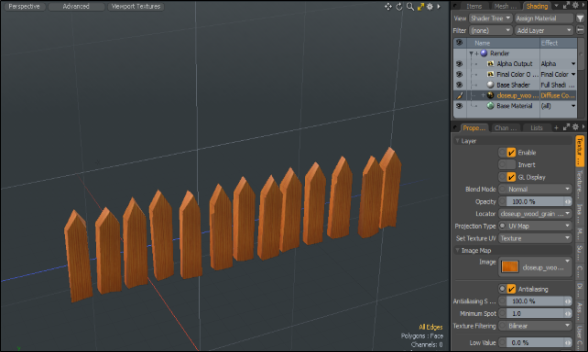
Jitter Tool Options
The following options are available for the Jitter tool:
|
Jitter |
||||
|---|---|---|---|---|
|
Enable X/Enable Y/Enable Z |
Enables the random jittering movement on a per axis basis for each axial direction. |
|||
| Enable U / Enable V |
When using the UV Editor, these options are displayed. They enable the random jittering position on the U and V directions. Note: Range Z is not available in the UV Editor. |
|||
|
Range X/Y/Z |
Controls the maximum random offset distance. Changing this value adjusts the strength of the jittering effect. |
|||
|
Seed |
Provides the initial number for Modo to use when generating the random values. Each seed produces different random results. |
|||
|
Rigid Translate |
Randomly move connected selections in X, Y and Z, or U and V direction. If you have a UV map, this option allows you to move each stacked island. |
|||
|
Rigid Rotate |
Randomly rotate connected selections in X, Y and Z, or U and V direction. |
|||
|
Rigid Scale |
Randomly scale connected selections in X, and Z, or U and V direction. |
|||
| Locked Stacked |
When using the UV Editor, this option displays. It locks and unlocks stacked UV's so they can be randomized as a group or as individual UV islands.
|
|||
|
Slip UVs |
When enabled, edits applied to the geometry do not change the existing UV map. UV values are generally fixed to specific vertices; therefore, further edits to the geometry may warp, deform, or otherwise distort the UV values in undesirable ways. When this happens, you may need to adjust the map or to redo it altogether. To avoid this undesirable result, you enable Slip UVs so as to not disturb any existing UV mapping applied to the geometry.
|
|||
|
Morph |
Determines how Modo treats stored morphing information when applying transforms (such as the Move, Rotate, or Scale transforms) to geometry. There are three options for controlling how Modo deals with the morph map vertex data when applying any transforms.
• None - Transforms selected (visible) morphs independent of their source, but does not affect unselected morph data.
• Transform - Transforms morph data along with the base mesh.
• Keep Positions - Converts morph data into an absolute morph map. All vertices retain their pre-transformed positions. Note: In previous versions of Modo, to transform a morph along with its base, you needed to select it in the Vertex Map list. If you didn't, when Modo recalled the relative morph map data, it would produce distorted, undesirable results; therefore, it was easy to accidentally spoil a model. To remedy this problem, current versions of Modo have three options to deal with the morph map vertex data. |
|||
